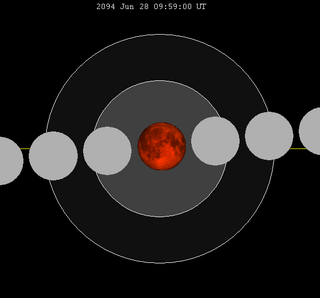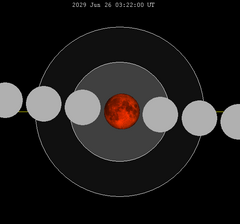
A total lunar eclipse took place on 3 March 2007, the first of two eclipses in 2007. The moon entered the penumbral shadow at 20:18 UTC, and the umbral shadow at 21:30 UTC. The total phase lasted between 22:44 UTC and 23:58 UTC with a distinctive brick-red shade. The moon left the umbra shadow at 01:11 UTC and left the penumbra shadow at 02:24 UTC 2007-03-04. The second lunar eclipse of 2007 occurred on 28 August.

A total lunar eclipse will take place between Monday and Tuesday, June 25-26, 2029. A central total eclipse lasting 1 hour and 41 minutes 53 seconds will plunge the full Moon into deep darkness, as it passes right through the centre of the Earth's umbral shadow. While the visual effect of a total eclipse is variable, the Moon may be stained a deep orange or red color at maximum eclipse. It will be able to be seen from most of the Americas, Western Europe and Africa. The partial eclipse will last for 3 hours and 39 minutes 32 seconds in total.

A total lunar eclipse took place on Friday, June 4, 1993, the first of two total lunar eclipses in 1993, the second being on Monday, November 29. The Moon was plunged into darkness for 1 hour and 36 minutes, in a deep total eclipse which saw the Moon 56% of its diameter inside the Earth's umbral shadow. The visual effect of this depends on the state of the Earth's atmosphere, but the Moon may have been stained a deep red colour. The partial eclipse lasted for 3 hours and 38 minutes in total. The moon passed through the center of the Earth's shadow.
A total lunar eclipse took place on Tuesday, July 6, 1982, the second of three total lunar eclipses in 1982, and the only one that was in the descending node. A dramatic total eclipse lasting 1 hour and 46 minutes plunged the full Moon into deep darkness, as it passed right through the centre of the Earth's umbral shadow. While the visual effect of a total eclipse is variable, the Moon may have been stained a deep orange or red colour at maximum eclipse. This was a great spectacle for everyone who saw it. The partial eclipse lasted for 3 hours and 56 minutes in total.

A total lunar eclipse will take place on July 7, 2047. It will last 1 hour 40 minutes and 49 seconds and will plunge the full Moon into deep darkness, as it passes right through the centre of the Earth's umbral shadow. While the visual effect of a total eclipse is variable, the Moon may be stained a deep orange or red colour at maximum eclipse. This will be a great spectacle for everyone who sees it. The partial eclipse will last for 3 hours and 39 minutes in total.
A total lunar eclipse took place on Friday, March 24, 1978, the first of two total lunar eclipses in 1978. The moon passed through the center of the Earth's shadow. The Moon was plunged into darkness for 1 hour, 30 minutes and 40.2 seconds, in a deep total eclipse which saw the Moon 45.179% of its diameter inside the Earth's umbral shadow. The visual effect of this depends on the state of the Earth's atmosphere, but the Moon may have been stained a deep red colour. The partial eclipse lasted for 3 hours, 38 minutes and 34.5 seconds in total.
A total lunar eclipse took place on Saturday, May 24 and Sunday, May 25, 1975, the first of two total lunar eclipses in 1975. The Moon was plunged into darkness for 1 hour and 28 minutes in a deep total eclipse which saw the Moon 43% of its diameter inside the Earth's umbral shadow. The visual effect of an eclipse depends on the state of the Earth's atmosphere, but the Moon may have been stained a deep red colour. The partial eclipse lasted for 3 hours and 35 minutes in total. Occurring only 4.4 days after perigee, the Moon's apparent diameter was 0.7% larger than average. The moon was 377,010 km from the Earth at greatest eclipse.
A total lunar eclipse took place on Friday, August 6, 1971, the second of two total lunar eclipses in 1971. A dramatic total eclipse lasting 1 hour, 39 minutes and 24.8 seconds plunged the full Moon into deep darkness, as it passed right through the centre of the Earth's umbral shadow. While the visual effect of a total eclipse is variable, the Moon may have been stained a deep orange or red colour at maximum eclipse. This was a great spectacle for everyone who saw it. The partial eclipse lasted for 3 hours, 35 minutes and 31.9 seconds in total. Occurring only 2.2 days before perigee, the Moon's apparent diameter was 3.6% larger than average and the moon passed through the center of the Earth's shadow.
A total lunar eclipse took place at the Moon's descending node of the orbit on Wednesday, February 10, 1971, the first of two total lunar eclipses in 1971. It had an umbral magnitude of 1.30819. The Moon passed through the center of the Earth's shadow. The Moon was plunged into darkness for 1 hour, 22 minutes and 11.4 seconds, in a deep total eclipse which saw the Moon 30.819% of its diameter inside the Earth's umbral shadow. The visual effect of this depends on the state of the Earth's atmosphere, but the Moon may have been stained a deep red colour. The partial eclipse lasted for 3 hours, 44 minutes and 42.9 seconds and in total. Occurring only 2.7 days before apogee, the Moon's apparent diameter was 5.9% smaller than average.
A total lunar eclipse took place on Thursday, April 24, 1986, the first of two total lunar eclipses in 1986, the second being on October 17, 1986. The Moon was plunged into darkness for 1 hour, 3 minutes and 34.8 seconds, in a deep total eclipse which saw the Moon 20.217% of its diameter inside the Earth's umbral shadow. The visual effect of this depends on the state of the Earth's atmosphere, but the Moon may have been stained a deep red colour. The partial eclipse lasted for 3 hours, 18 minutes and 46.8 seconds in total. The Moon was just 1.2 days before perigee, making it 5.3% larger than average.
A total lunar eclipse took place on Saturday, September 16, 1978, the second of two total lunar eclipses in 1978. The Moon was plunged into darkness for 1 hour, 18 minutes and 39 seconds, in a deep total eclipse which saw the Moon 32.683% of its diameter inside the Earth's umbral shadow. The visual effect of this depends on the state of the Earth's atmosphere, but the Moon may have been stained a deep red colour. The partial eclipse lasted for 3 hours, 27 minutes and 11.6 seconds in total.

A total lunar eclipse took place on Monday, May 13, 1957, the third of fourteen total lunar eclipses of Lunar Saros 130. The Moon was plunged into darkness for 1 hour and 18 minutes, in a deep total eclipse which saw the Moon 30% of its diameter inside the Earth's umbral shadow. The visual effect of this depends on the state of the Earth's atmosphere, but the Moon may have been stained a deep red colour. The partial eclipse lasted for 3 hours and 32 minutes in total.

A total lunar eclipse took place on Wednesday, May 3, 1939. A shallow total eclipse saw the Moon in relative darkness for 1 hour and 2 minutes. The Moon was 18% of its diameter into the Earth's umbral shadow, and should have been significantly darkened. The partial eclipse lasted for 3 hours and 27 minutes in total.
A total lunar eclipse took place on Friday, April 22, 1921. This was the first total lunar eclipse of Saros cycle 130. A shallow total eclipse saw the Moon in relative darkness for 40 minutes and 6 seconds. The Moon was approximately 7% of its diameter into the Earth's umbral shadow, and should have been significantly darkened. The partial eclipse lasted for 3 hours and 22 minutes in total.
A partial lunar eclipse took place on Sunday, April 12, 1903. This nearly total lunar eclipse of Saros cycle 130 preceded the first total eclipse on April 22, 1921. The Moon was almost covered by the Earth's shadow in a very deep partial eclipse, which lasted 3 hours and 17 minutes. With 96.77% of the Moon in shadow at maximum eclipse, this was quite a memorable event.

A total lunar eclipse will take place on July 29, 2083. The Moon will be plunged into darkness for 1 hour and 30 minutes, in a deep total eclipse which will see the Moon 48.3% of its diameter inside the Earth's umbral shadow. The visual effect of this depends on the state of the Earth's atmosphere, but the Moon may be stained a deep red colour. The partial eclipse will last for 3 hours and 33 minutes in total.

A total lunar eclipse will take place on June 17, 2076. The moon will pass through the center of the Earth's shadow. While the visual effect of a total eclipse is variable, the Moon may be stained a deep orange or red color at maximum eclipse. With a gamma value of only −0.0452 and an umbral eclipse magnitude of 1.7943, this is the second greatest eclipse in Saros series 131 as well as the largest and darkest lunar eclipse between June 26, 2029 and June 28, 2094. Overall, it will be the third largest and darkest lunar eclipse of the 21st century. While it will have similar values to the lunar eclipse of July 16, 2000, totality will not last over 106 minutes due to the moon's relatively large apparent size as seen from Earth and greater speed in its elliptical orbit. Totality's expected to last 100 minutes 34 seconds from 9:11:39 to 10:52:15 with the greatest point at 10:01:57 UTC.

A total lunar eclipse will take place on June 28, 2094. The moon will pass through the center of the Earth's shadow. While the visual effect of a total eclipse is variable, the Moon may be stained a deep orange or red color at maximum eclipse. With a gamma value of only 0.0288 and an umbral eclipse magnitude of 1.8234, this is the greatest eclipse in Saros series 131 as well as the second largest and darkest lunar eclipse of the 21st century.

A total lunar eclipse took place on Sunday, July 26, 1953.

A total lunar eclipse will occur on Wednesday, June 9, 2123, with maximum eclipse at 05:06 UTC. A dramatic total eclipse lasting 106 minutes and 6 seconds will plunge the full Moon into deep darkness, as it passes right through the centre of the Earth's umbral shadow. While the visual effect of a total eclipse is variable, the Moon may be stained a deep orange or red colour at maximum eclipse. This will be a great spectacle for everyone who sees it. The partial eclipse will last for 3 hours and 56 minutes in total. The penumbral eclipse lasts for 6 hours and 14 minutes. Maximum eclipse is at 05:06:28 UT. This will be the longest Total Lunar Eclipse since 16 July 2000, and the longest one until 12 May 2264 and 27 July 3107, though the eclipse on June 19, 2141 will be nearly identical in all aspects. This will also be the longest of the 22nd century and the second longest of the 3rd millennium. The eclipse on June 19, 2141 will be the second longest of the 22nd century and the third longest of the third millennium.








































